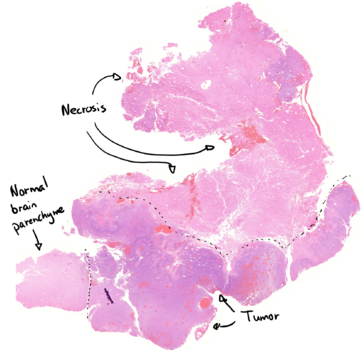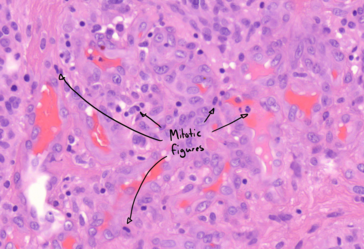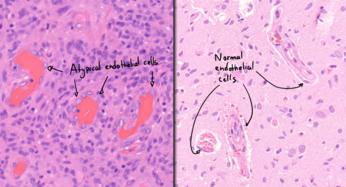22. Glioblastoma: Difference between revisions
No edit summary |
No edit summary |
||
| Line 23: | Line 23: | ||
Glioblastoma is a grade IV astrocytic tumor that is defined histologically be the four characteristics described above. It must be differentiated from ''anaplastic astrocytoma'', a grade III astrocytic tumor. Anaplastic astrocytoma also shows severe atypia and many mitotic figures but no pseudopalisading necrosis or microvascular proliferation. | Glioblastoma is a grade IV astrocytic tumor that is defined histologically be the four characteristics described above. It must be differentiated from ''anaplastic astrocytoma'', a grade III astrocytic tumor. Anaplastic astrocytoma also shows severe atypia and many mitotic figures but no pseudopalisading necrosis or microvascular proliferation. | ||
[[File:Glioblastoma - atypia.png|thumb|Tumor cells show severe atypia and there are many mitotic figures present. | [[File:Glioblastoma - atypia.png|thumb|Tumor cells show severe atypia and there are many mitotic figures present.|364x364px]] | ||
[[File:Glioblastoma - microvascular proliferation.png|thumb|Tumor on the left, showing microvascular proliferation. Normal brain parenchyme on the right for comparison.|346x346px]] | [[File:Glioblastoma - microvascular proliferation.png|thumb|Tumor on the left, showing microvascular proliferation. Normal brain parenchyme on the right for comparison.|346x346px]] | ||
[[Category:Pathology 2 - Histopathology slides]] | [[Category:Pathology 2 - Histopathology slides]] | ||
Latest revision as of 14:06, 7 July 2024

Staining: HE
Organ: Brain
Description:
There are four important characteristics in glioblastomas:
- Severe atypia
- Many mitotic figures
- Pseudopalisading necrosis
- Microvascular proliferation
Microvascular proliferation is a phenomenon where the tumor contains small capillaries who are irregular and are comprised of atypical endothelial cells.
Pseudopalisading necrosis is a phenomenon where the tumor contains areas of necrosis, and this necrosis is surrounded by hypercellular regions.
Diagnosis: Glioblastoma

Risk factors:
- Age 50 – 70
Theory:
Glioblastoma is a grade IV astrocytic tumor that is defined histologically be the four characteristics described above. It must be differentiated from anaplastic astrocytoma, a grade III astrocytic tumor. Anaplastic astrocytoma also shows severe atypia and many mitotic figures but no pseudopalisading necrosis or microvascular proliferation.


